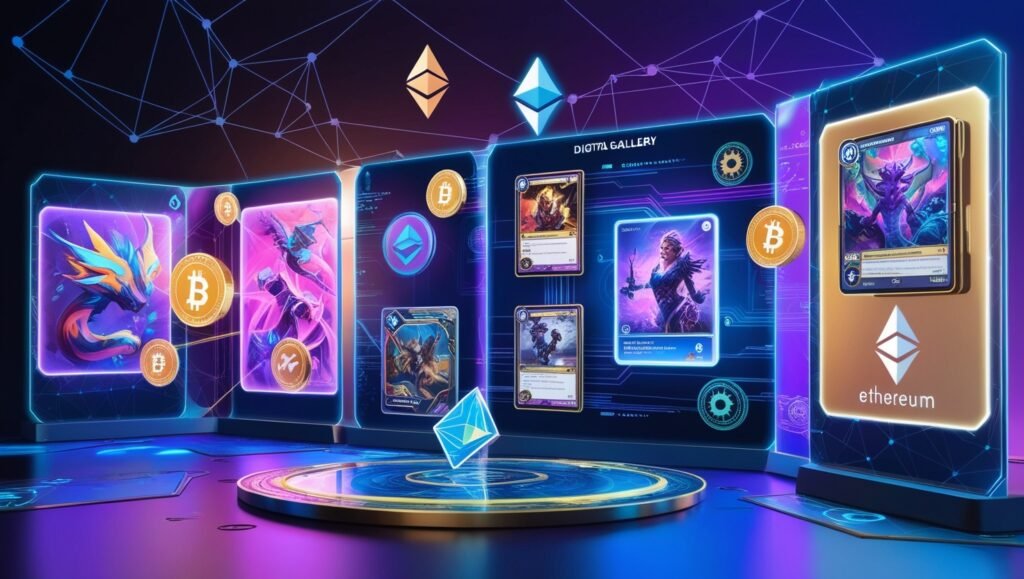Non-fungible tokens (NFTs) have become one of the most talked-about innovations in the world of blockchain technology. From digital art and collectibles to gaming and real estate, NFTs are reshaping the way we think about ownership and value in the digital age. But what exactly are NFTs, and how do they work? In this guide, we’ll break down everything you need to know about NFTs, their use cases, benefits, risks, and how to get started.
What Is an NFT?
An NFT, or non-fungible token, is a unique digital asset that represents ownership of a specific item or piece of content, recorded on a blockchain. Unlike cryptocurrencies such as Bitcoin or Ethereum, which are interchangeable (fungible), each NFT is one-of-a-kind and cannot be replaced with something identical.
Key Characteristics of NFTs
- Uniqueness: Every NFT has a unique identifier, making it distinct from any other token.
- Ownership: Blockchain technology ensures transparent and verifiable ownership.
- Indivisibility: Most NFTs cannot be divided into smaller units; they exist as whole entities.
- Interoperability: NFTs can be bought, sold, or traded across various marketplaces and platforms.
- Programmability: Smart contracts embedded within NFTs can enable royalties or other features.
How Do NFTs Work?
NFTs are powered by blockchain technology, which acts as a decentralized ledger to record transactions. Most NFTs are created and traded on the Ethereum blockchain, although other networks like Solana, Binance Smart Chain, and Tezos also support NFTs.
Steps to Create and Trade an NFT
- Minting: Creating an NFT involves “minting” a digital asset on the blockchain. This process assigns a unique token to the asset.
- Storing: The NFT itself is stored on the blockchain, while associated content (e.g., an image or video) may be stored off-chain using solutions like IPFS.
- Buying and Selling: NFTs are bought and sold on marketplaces like OpenSea, Rarible, and Foundation using cryptocurrency.
- Transferring Ownership: Ownership of an NFT is transferred to the buyer once the transaction is confirmed on the blockchain.
Where Can You Find NFTs?
NFTs are available on a variety of online marketplaces, each catering to different types of assets and audiences. Here are some popular platforms:
- OpenSea: The largest NFT marketplace, offering a wide range of digital art, collectibles, and domain names.
- Rarible: A decentralized platform that allows users to create, buy, and sell NFTs with ease.
- Foundation: Focused on high-quality digital art and limited-edition NFTs.
- SuperRare: An exclusive platform for unique, single-edition digital artworks.
- NBA Top Shot: Specializes in sports collectibles, particularly NBA highlights.
- Decentraland Marketplace: A platform for buying virtual land and items within the Decentraland metaverse.
These platforms require users to set up a digital wallet and purchase cryptocurrency to participate in the NFT ecosystem.

Why Do People Invest in NFTs?
NFT investments are driven by a variety of motivations, ranging from financial gains to personal interests. Here are some key reasons:
- Potential for High Returns:
- Early adopters of NFTs like CryptoPunks and Bored Apes have seen massive returns on their investments.
- The speculative nature of NFTs allows for significant price appreciation in a short period.
- Ownership of Unique Assets:
- NFTs enable collectors to own exclusive digital content, such as art, music, or virtual real estate.
- Supporting Creators:
- Many people invest in NFTs to directly support artists and creators, who benefit from royalties on secondary sales.
- Status Symbol:
- Owning rare or high-profile NFTs can be a digital status symbol, much like luxury goods in the physical world.
- Diversification:
- NFTs provide an alternative asset class, helping investors diversify their portfolios beyond traditional investments like stocks and real estate.
- Participation in Emerging Technologies:
- Investors see NFTs as a way to engage with cutting-edge blockchain technology and its evolving applications.
Use Cases for NFTs
1. Digital Art
NFTs have revolutionized the art world by enabling artists to sell their work directly to collectors. Examples include:
- Beeple’s “Everydays: The First 5000 Days”, which sold for $69 million.
- Generative art collections like CryptoPunks and Bored Ape Yacht Club.
2. Gaming
In-game assets such as skins, weapons, and virtual real estate can be tokenized as NFTs, allowing players to truly own and trade their items. Games like Axie Infinity and Decentraland are leading this movement.
3. Music and Media
Musicians and creators can release their work as NFTs, giving fans a chance to own exclusive content while ensuring artists retain royalties.
4. Collectibles
NFTs have become digital collectibles, such as trading cards, sports highlights, and memorabilia. Examples include NBA Top Shot and Sorare.
5. Virtual Real Estate
Platforms like Decentraland and The Sandbox allow users to buy, sell, and develop virtual land as NFTs.
Benefits of NFTs
- True Ownership: Blockchain ensures that ownership is transparent and secure.
- Royalty Streams: Creators can earn royalties on secondary sales, enabling long-term income.
- Accessibility: NFTs make it easier for artists and creators to reach global audiences without intermediaries.
- Verifiable Authenticity: Blockchain technology eliminates concerns about counterfeits or fraud.
- Interoperability: NFTs can be used across multiple platforms and ecosystems.
Risks and Challenges of NFTs
1. Volatility
NFT prices can fluctuate dramatically, making them a high-risk investment.
2. Environmental Concerns
Some blockchains, like Ethereum, consume significant energy, raising concerns about their environmental impact. However, newer networks like Ethereum 2.0 and Solana are more energy-efficient.
3. Fraud and Scams
Fake NFTs and phishing scams are prevalent in the space. It’s essential to verify the authenticity of an NFT and the credibility of the marketplace.
4. Speculation
Many NFTs are bought as speculative assets, which could lead to bubbles and significant losses.
5. Limited Regulation
The NFT market operates in a largely unregulated environment, which poses risks to buyers and sellers.
How to Get Started with NFTs
1. Set Up a Digital Wallet
- Use wallets like MetaMask, Trust Wallet, or Coinbase Wallet to store your cryptocurrency and NFTs.
2. Buy Cryptocurrency
- Purchase Ethereum (or other blockchain-specific tokens) to pay for NFTs and transaction fees.
3. Choose a Marketplace
- Popular platforms include:
- OpenSea: The largest NFT marketplace.
- Rarible: A decentralized marketplace for various NFT types.
- Foundation: Focused on high-quality digital art.
4. Research and Verify
- Understand the creator and the project behind an NFT before making a purchase. Check for authenticity and community engagement.
5. Start Small
- Begin with affordable NFTs to familiarize yourself with the process before committing significant funds.
Future of NFTs
The potential of NFTs extends far beyond their current use cases. Key trends to watch include:
- Integration with the Metaverse
- NFTs will play a crucial role in virtual economies, enabling ownership of assets within the metaverse.
- Tokenization of Real-World Assets
- Real estate, luxury goods, and intellectual property could be tokenized as NFTs for easier buying, selling, and ownership tracking.
- Increased Regulation
- Governments may introduce regulations to protect consumers and reduce fraud in the NFT space.
- Mass Adoption
- As NFTs become more user-friendly, mainstream adoption will accelerate across industries.
Conclusion
NFTs represent a groundbreaking innovation in digital ownership and value creation. While they offer exciting opportunities for creators, collectors, and investors, it’s essential to approach the space with caution and education. By understanding the technology, exploring use cases, and recognizing the risks, you can navigate the NFT landscape confidently.
Ready to dive into the world of NFTs? Visit The Finance Bot for expert insights, step-by-step guides, and the latest trends in blockchain technology and digital assets!



